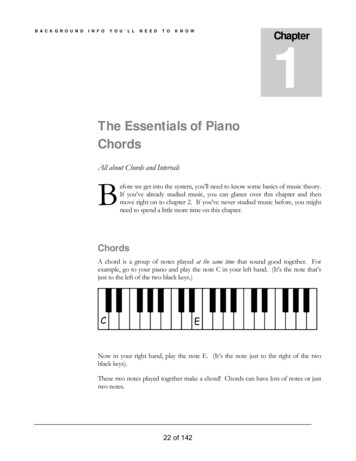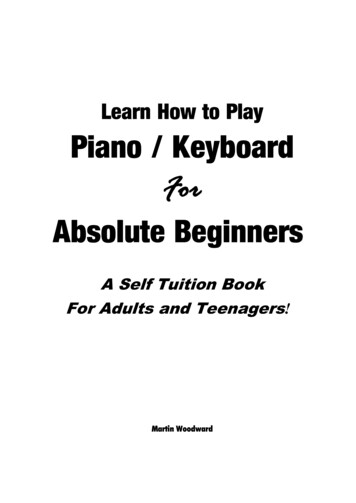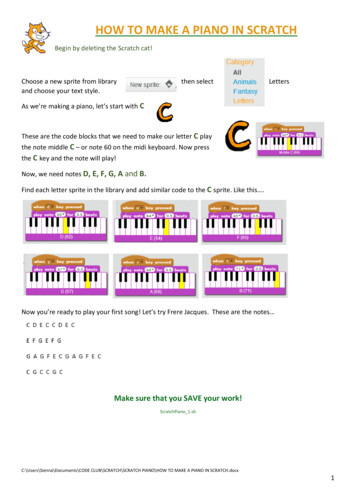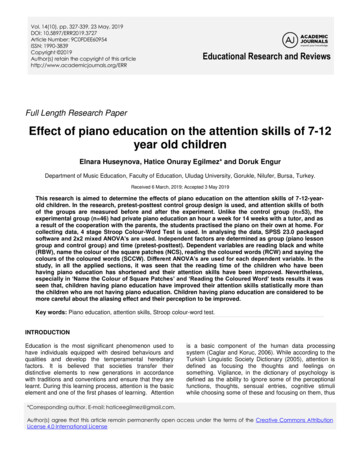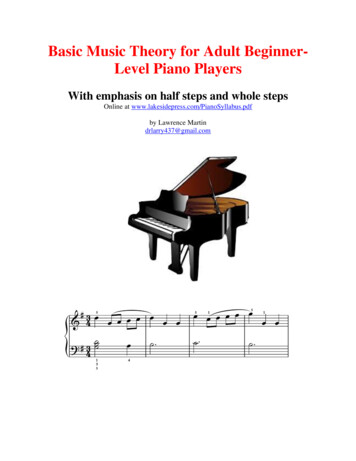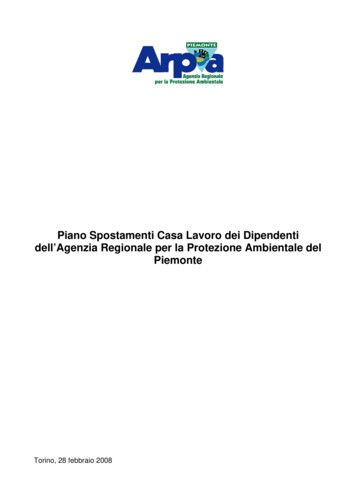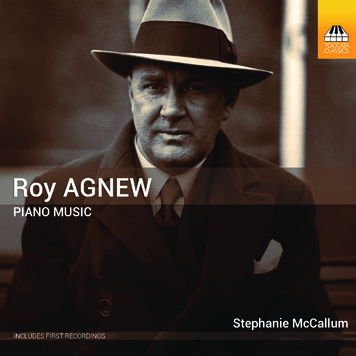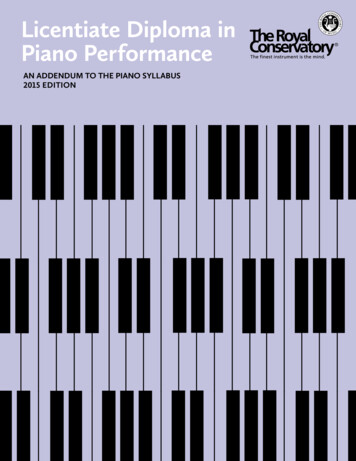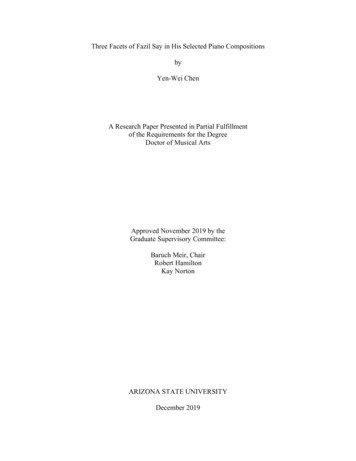
Transcription
FundamentalsofPiano Practiceby Chuan C. Chang
To my wifeMerryand our daughtersEileen and Sue-LynnThe material of Chapter One originated from my notes on how the late Mlle. Yvonne Combe taughtour daughters. Mlle. Combe was Debussy's disciple and helped transcribe his new compositions as he playedthem out on the piano. She performed that incredible Second Piano Concerto by Saint Saens with thecomposer conducting. Every audience that attended recitals by her students, especially when they playedDebussy and Saint Saens, was mesmerized. This book had to be written: without it, her passing would havedeprived this world of a priceless art.Chapter One: PIANO TECHNIQUEChapter Two: TUNING YOUR PIANOReferencesMarch 6, 2009Copyright 2009, copy permitted if author’s name,Chuan C. Chang, and this copyright statement are included.ISBN: 1-4196-7859-0ISBN-13: 978-419678592Library of Congress Control Number: 2007907498Order this book at www.booksurge.com or Amazon.comThis entire book can be downloaded free at:http://www.pianopractice.org/1
Table of ContentsTestimonials . 6Abbreviations and Frequently Used Phrases. 14Preface. 16CHAPTER ONE: PIANO TECHNIQUE . 24I. INTRODUCTION . 241. Objective . 242. What is Piano Technique?. 253. Technique, Music, Mental Play . 264. Basic Approach, Interpretation, Musical Training, Absolute Pitch . 26II. BASIC PROCEDURES FOR PIANO PRACTICE . 281. The Practice Routine. 282. Finger Positions. 293. Bench Height and Distance from Piano . 304. Starting a Piece: Listening and Analysis (Fur Elise). 305. Practice the Difficult Sections First . 316. Shortening Difficult Passages: Segmental (Bar-by-Bar) Practice. 317. Hands Separate Practice: Acquiring Technique. 318. Continuity Rule . 329. Chord Attack . 3310.Gravity Drop, Chord Practice, and Relaxation. 3311.Parallel Sets . 3512.Learning, Memorizing, and Mental Play. 3613.Velocity, Choice of Practice Speed. 3814.How to Relax. 3915.Post Practice Improvement (PPI) . 4116.Dangers of Slow Play - Pitfalls of the Intuitive Method . 4217.Importance of Slow Play . 4318.Fingering . 4419.Accurate Tempo and the Metronome. 4520.Weak Left Hand; Using One Hand to Teach the Other. 4621.Building Endurance, Breathing . 4722.Bad Habits: A Pianist's Worst Enemy. 4923.Damper Pedal . 5124.Soft Pedal: Hammer Voicing, Physics of the Piano Sound. 5225.Hands Together and Mental Play . 55Beehoven’s Moonlight, 1st Movement, Op. 27, No. 2 . 56Mozart’s Rondo Alla Turca, from Sonata K300 (K331). . 59Chopin's Fantaisie-Impromptu, Op. 66, Fast Play Degradation (FPD). 6126.Summary . 64III. SELECTED TOPICS IN PIANO PRACTICE . 641. Tone, Rhythm, Legato, staccato. 64a.What is "Good Tone"?The Basic Keystroke. . 64Tone: Single versus Multiple Notes, Pianissimo, Fortissimo. . 65b.What is Rhythm? (Beethoven’s Tempest, Op. 31, #2, Appassionata, Op. 57) . 69c.Legato, Staccato . 712. Cycling (Chopin's Fantaisie Impromptu). 723. Trills & Tremolos . 76a.Trills . 76b.Tremolos (Beethoven's Pathetique, 1st Movement). 772
4. Hand, Finger, Body Motions for Technique. 79a.Hand Motions (Pronation, Supination, Thrust, Pull, Claw, Throw, Flick, Wrist) . 79b.Playing with Flat Fingers (FFP, Spider, Pyramid Positions) . 80c.Body Motions . 885. Playing Fast: Scales, Arpeggios, and Chromatic Scales. 89a.Scales: Thumb Under, Thumb Over (TU, TO). 89b.The TO Motion, Explanation and Video . 91c.Practicing TO: Speed, Glissando Motion . 92d.Scales: Origin, Nomenclature and Fingerings . 96e.Arpeggios (Chopin’s Fantaisie Impromptu, Cartwheel Motion, Finger Splits) . 98f.Thrust and Pull, Beethoven's Moonlight, 3rd Movement . 100g.Thumb: the Most Versatile Finger. 103h.Fast Chromatic Scales. 1036. Memorizing . 104a.Why Memorize? . 104b.Who can, What to, and When to, Memorize. . 106c.Memorizing and Maintenance . 106d.Hand Memory. 107e.Starting the Memorizing Process. 107f.Reinforcing the Memory. 108g.Practicing Cold . 109h.Slow Play . 109i.Mental Timing . 110j.Establishing Permanent Memory, Mental Play . 110Music memory. 111Photographic memory. 111Keyboard memory and mental play. 112Theoretical memory. 114k.Maintenance. 114l.Sight Readers versus Memorizers. 115Bach's 2-part Inventions: #1, #8, and #13. . 116Quiet hands. 120Sinfonia #15. 121m. Human Memory Function; Music Memory Algorithm . 122n.How to Become a Good Memorizer . 124o.Summary. 1257. Exercises. 126a.Introduction: Intrinsic, Limbering, and Conditioning Exercises . 126Fast vs. Slow Muscles . 127b.Parallel Set Exercises for Intrinsic Technical Development. 128c.How To Use The Parallel Set Exercises (Beethoven’s Appassionata, 3rd Movement) . 134d.Scales, Arpeggios, Finger Independence and Finger Lifting Exercises . 135e.Playing (Wide) Chords, Finger/Palm Spreading Exercises . 136f.Practicing Jumps. 138g.Stretching and Other Exercises. 139h.Problems with Hanon Exercises . 139i.Practicing for Speed . 142Speed Stroke, Relaxation. 142Other Speed Methods .
of time, allowing you to concentrate on teaching music. The Preface is a good overview of the book, and the book reviews in the Reference section contains detailed reviews of the most relevant books. Students: If you don’t have a teacher, pick any piece of music you want to learn (that is
